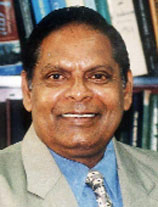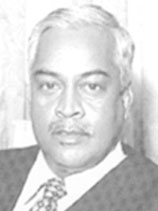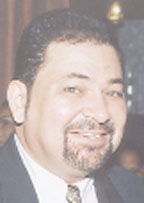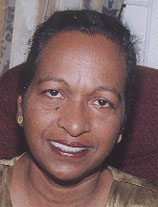As President Bharrat Jagdeo prepares to celebrate the tenth anni-versary as Guyana’s longest-serving head of state, the manner in which he selects and rejects persons to fill the seats of power in the cabinet will determine the destiny of the country.
Questioned about the composition of his cabinet in the wake of the March 2001 general election, President Bharrat Jagdeo answered simply “I had restrictions placed on my ability to appoint people.” This was an acknowledgement of the power of the hierarchy of the People’s Progressive Party to influence the selection of the ministers who would form the administration and, thereby, determine how the government would be run. It also signified the party’s determination to retain collective political control of the administrative apparatus of the state and showed that it appreciated the need to reward its retainers.

Size matters
PPP/C cabinets have typically been large – an average of about twenty members – in order to accommodate four separate components. First, the core section made up of elected party central and executive committee members; second, the civic section which preserves the notion of the 1992 ‘civic’ alliance; third, the technocratic section made up of ministers who are recruited more for their professional expertise than their political loyalty; and, fourth, the constituents’ section which, as a concession to minority interests, tries to provide the sort of gender, ethnic, religious and regional balance that creates the impression of a representative and inclusive team.
The party also invented expensive ‘ersatz’ ministries by temporarily splitting established ministries into two parts in order to satisfy these varied interests. This allowed the appointment of persons who otherwise would be left out of the cabinet. After they left, the ministries could be discarded completely or re-consolidated.
This practice started under Dr Cheddi Jagan with the creation of the Ministry of Information to accommodate Moses Nagamootoo but was abolished after he went off to study. Similarly, the Ministry of Fisheries, Other Crops and Livestock was created to accommodate Satayadeow Sawh but which was abolished after he died. Mr Jagdeo more recently created the Ministry of Foreign Trade and International Cooperation to accommodate Clement Rohee and, later, Henry Jeffrey, but abolished it after Jeffrey resigned. Other ad hoc devices have been the employment of junior ministers within existing ministries and of a large number of presidential and ministerial ‘advisers.’

Things changed gradually over the past decade. It now seems that, in addition to satisfying the party’s criteria for cabinet appointment, the president has succeeded in selecting a subset of persons who are personally loyal to him and in rejecting persons who might be unfriendly. The well-publicised exchange with party stalwart Moses Nagamootoo is a case in point. In the wake of the 2006 general election, the president promptly declared all the positions sought by Nagamootoo – not considered to be a presidential favourite – to be “unavailable” and had been filled by others. In so doing, the president showed that, between 2001 and 2006, he was able to remove the “restrictions” on his ability to select ministers.
The strengthening of the president’s authority has affected the evolution of the cabinet over the past decade in major ways. Today, only four persons – Shaik Baksh; Samuel Hinds; Clement Rohee and the recently reappointed Charles Ramson – survive from the team Mr Jagdeo inherited from Mrs Jagan at the start of his presidency. Where have all the others gone?
Dream teams
It was in a carefully choreographed but almost comical constitutional fandango in August 1999, that President Janet Jagan announced that she was resigning. Because Prime Minister Samuel Hinds was her legal successor, however, his resignation had to precede hers permitting the appointment of Minister of Finance Bharrat Jagdeo as Prime Minister. This then enabled Mr Jagdeo to succeed Mrs Jagan and, when he was sworn in as President on 11th August, he reappointed Mr Hinds as Prime Minister.

That done, President Jagdeo inherited Mrs Jagan’s 1998 cabinet. But his own portfolio of Finance had to be filled and, as Michael Shree Chand died in November 1998, he also had to be replaced. These changes necessitated the appointment of Sasenarine Kowlessar as Minister within the Office of the President with responsibility for Financial Matters, and Geoffrey da Silva as Minister of Trade, Tourism and Industry. Significantly, it has been the tradition of all five previous executive presidents in this country to hold on to the defence portfolio but, from 1998 to 2006, the president made himself responsible for the finance portfolio as well.
With an enhanced popular mandate in the March 2001 elections, President Jagdeo attempted his first big cabinet purge. He did not reappoint five ministers – Vibert de Souza; George Fung-On; Geoffrey da Silva; Indranie Chandarpal; and Charles Ramson. He also invented two new ‘ersatz’ ministries – Parliamentary Affairs and Foreign Trade and International Cooperation, respectively – to accommodate Reepu Daman Persaud and Clement Rohee who were both shifted sideways in the cabinet. In their place, he appointed Navindranauth Chandarpal; Carolyn Rodrigues; Bibi Shadick; and Dr Jennifer Westford and, subsequently, Rudolph Insanally, Manzoor Nadir and Doodnauth Singh. Chandarpal resigned suddenly after a little more than a year; no replacement was appointed and Satyadeow Sawh acted as Minister of Agriculture until April 2006.
This was a period of unprecedented crisis in the cabinet. In the first instance, owing to allegations made against him, Minister of Home Affairs Ronald Gajraj was the subject of a presidential commission of inquiry convened to investigate whether he was “involved in promoting, directing or otherwise engaged in activities which have involved the extra-judicial killing of persons.”
The inquiry, however, found that there was no credible evidence against him. In the second instance, Satyadeow Sawh was assassinated at his home in April 2006, a serious failure of security.

Mr Jagdeo was re-elected for another five-year term on 28th August 2006 and he launched the biggest cabinet purge on record, removing eight ministers – Dale Bisnauth; Clinton Collymore; Sasenarine Kowlessar; Harripersaud Nokta; Reepu Daman Persaud; Bibi Shadick; Gail Teixeira and Anthony Xavier. He also established the largest PPP cabinet of all time comprising twenty-one ministers (himself included) among whom were Frank Anthony; Robeson Benn; Desrey Fox; Kellawan Lall; Priya Manickchand; Harry Narine Nawbatt; Robert Persaud; Manniram Prashad; Bheri Ramsaran; Ashni Singh; and Jennifer Webster. The number of ministries with junior ministers – Education, Finance, Health, and Labour – also increased.
Over the next sixteen months, Rudolph Insanally, Henry Jeffrey, Harry Narine Nawbatt and Doonauth Singh retired from the cabinet and Mohamed Irfaan Ali, Pauline Sukhai and Charles Ramson were appointed.
Farewell civic
These changes had several effects. With the departure of Dale Bisnauth, Henry Jeffrey, George Fung-On and Anthony Xavier, all of whom used to be considered members of the ‘civic’ component, could the administration still be correctly described as PPP-Civic? The appointment of Manzoor Nadir, who is still the leader of the shrinking United Force party, remains an anomaly; there has been neither an indication of a formal coalition between the PPPC and TUF nor has Nadir been designated a member of the ‘civic’ component. If the civic component was intended initially to be a group of private citizens who could make a distinct intellectual or ideological contribution to governance, either individually or collectively, it has definitely outlived its usefulness.
In ethnic terms, removing the only ministers of Chinese and of Portuguese descent but, at the same time, increasing the number of Amerindians, might have been a strategic electoral calculation which reflected the country’s changed demographic reality. The present cabinet composition is approximately 62 per cent Indian, 24 per cent African and 14 per cent Amerindian. And, for the first time, 28 per cent of the ministers are women and the average age of the cabinet has fallen to just below 50 years.
Politically, nine members of the cabinet, or about 43 per cent, are elected members of the PPP Central Committee and, for the first time, the cabinet now contains at least four persons who have been educated in Russia. In addition, in professional terms, with the inclusion of the cabinet secretary Dr Roger Luncheon, the cabinet now contains five medical doctors while the government still relies on Cuban and Chinese medical brigades to run its hospitals. Educationally, with only three exceptions, cabinet ministers have all attended university.
President Bharrat Jagdeo is now, next to Prime Minister Samuel Hinds and Home Affairs Minister Clement Rohee, the longest-serving member of the cabinet and exudes the confidence that comes with experience. In the final analysis, it is he, not any party committee, who bears ultimate responsibility for moulding the different components and personalities into an efficient team. Once in the cabinet, so the theory goes, ministers ought not to pursue party interests or their own personal desires but should administer the government on behalf of all citizens. Under the present constitutional system, he must judiciously and pragmatically assess the political and personal qualities of each candidate in order to choose who will occupy the seats of power.
